Description
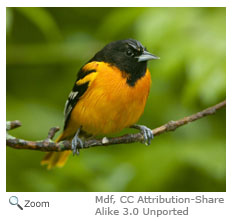 The Baltimore oriole is one of the brightest birds in the forest. The male has a black head, back, wings, and tail and an orange breast and shoulder patch. The male is much more colorful than the female, who is olive brown with a dull yellow front. The Baltimore oriole is common in New Hampshire; try spotting a nest hanging from a tree branch in the winter! The Baltimore oriole is one of the brightest birds in the forest. The male has a black head, back, wings, and tail and an orange breast and shoulder patch. The male is much more colorful than the female, who is olive brown with a dull yellow front. The Baltimore oriole is common in New Hampshire; try spotting a nest hanging from a tree branch in the winter!
Range
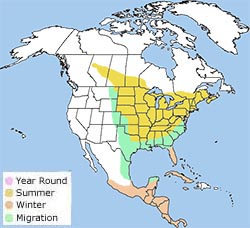 The Baltimore oriole breeds in the eastern US and southern Canada. It winters in Florida, the Caribbean, Mexico, and Central and South America. It arrives in its breeding range in early spring, and may leave as early are July. The Baltimore oriole breeds in the eastern US and southern Canada. It winters in Florida, the Caribbean, Mexico, and Central and South America. It arrives in its breeding range in early spring, and may leave as early are July.
Habitat
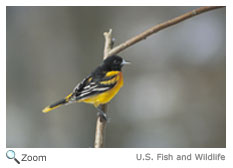 The Baltimore oriole spends its time high in deciduous trees looking for fruit and insects. It is found in open woodlands, on forest edges, in orchards, along rivers, and in parks and backyards. In their winter habitat in Central America, they can be found be found on shady coffee and cocoa plantations. The Baltimore oriole spends its time high in deciduous trees looking for fruit and insects. It is found in open woodlands, on forest edges, in orchards, along rivers, and in parks and backyards. In their winter habitat in Central America, they can be found be found on shady coffee and cocoa plantations.
|
|
Diet
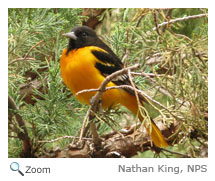 An omnivore, the Baltimore oriole eats insects, fruit, and nectar from flowers. It eats caterpillars and other insects during the summer when it is breeding and feeding its young. During the spring and fall, the Baltimore oriole eats fruit to gain energy for migration. The oriole prefers dark, ripe fruit like cherries and deep purple grapes. An omnivore, the Baltimore oriole eats insects, fruit, and nectar from flowers. It eats caterpillars and other insects during the summer when it is breeding and feeding its young. During the spring and fall, the Baltimore oriole eats fruit to gain energy for migration. The oriole prefers dark, ripe fruit like cherries and deep purple grapes.
Life Cycle
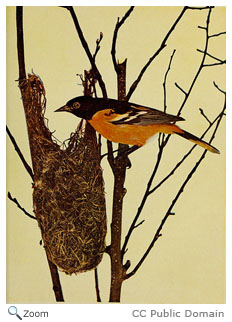 The female builds a remarkable nest 25-30 free above the ground. It looks like a hanging basket! The nests are much easier to see in the winter after trees have lost their leaves. The Baltimore oriole lays 4-6 speckled gray-blue eggs and incubates them for 11-14 days. Both parents feed the young chicks, who stay with their parents for two weeks after hatching. The female builds a remarkable nest 25-30 free above the ground. It looks like a hanging basket! The nests are much easier to see in the winter after trees have lost their leaves. The Baltimore oriole lays 4-6 speckled gray-blue eggs and incubates them for 11-14 days. Both parents feed the young chicks, who stay with their parents for two weeks after hatching.
Behavior
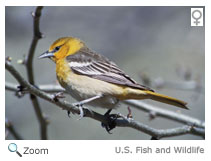 Sometimes, the Baltimore Oriole feeds in an odd way called "gaping". It stabs its closed bill into a soft fruit and then opens its mouth, catching the juice inside to drink with its tongue. Sometimes, the Baltimore Oriole feeds in an odd way called "gaping". It stabs its closed bill into a soft fruit and then opens its mouth, catching the juice inside to drink with its tongue. |